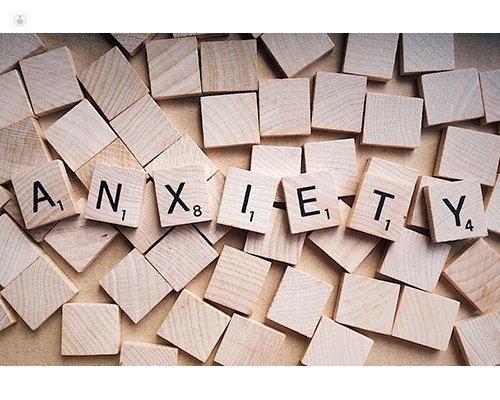How to detect and treat anxiety
Written by:To begin to approach the term anxiety should differentiate it from very close terms that often tend to make them equivalent when they are not exactly. We refer to differentiate anxiety from stress and anxiety.
Many of the symptoms that the body pours in times of stress and anxiety are very similar, and the difference must be sought in the particular function of each.
We understand stress psychology and psychophysiological changes in a person in response to a situation that demands more resources available to the subject. It therefore is a natural human response to actual overuse of the medium.
Anxiety is also a response of the organism that is derived from psychophysiological disorder that is experienced in anticipation of potentially threatening situation, be it more or less likely. It therefore represents the expectation; an expectation fretting about something that will happen or may attend.
Finally, we define the anguish c omo something closer to an existential condition; ie it is suffering, something turned to the subject himself. The words that define the anguish focus on the suffering of the subject and describe it, instead the words used to define anxiety are more orderly in expectation of what the future.

Incidence of anxiety in Spain
Globally, the prevalence of people affected by any anxiety related disorder is about 30%; ie 1 in 3 people suffer anxiety in one way or another throughout his life. There is more prevalent in the West than in the East.
In Spain, the involvement of anxiety disorders stands at 7%, beating depression. The most prevalent age fork precipitation of this disorder is between 18 and 34 years. Instead, people affected significantly down from 65.
GAD (generalized anxiety disorder) is the most seen by the general practitioner, and has a prevalence among the general population of 3% (and between 5-7% among patients attending primary care consultation).
Anxiety is the disease with the highest incidence among people aged 40 to 50 years and affects women more than 2 times (although the TAG incidence declines with age in men progresses, increases in women).
Symptoms of Anxiety
Anxiety states confirm a personality type that is in a permanent state of tension, with a leading role of worry and anxious anticipation.
Patients have feelings of discomfort and uneasiness widespread and persistent, that are not related to any particular environmental circumstances. Habitual includes the patient complains of being constantly nervous, and feeling other typical symptoms of anxiety, such as trembling, excessive sweating, muscle aches, dizziness, dizziness, rapid heartbeat, and gastric disorders. These are the determinants to make the diagnosis of anxiety disorder (apprehension, muscle aches and vegetative hyperactivity: dizziness, sweating, rapid heartbeat ... almost every day for several weeks).
 The particularity of anxiety in children is fixed from that they manifested a constant need for security and care as well as a repeated and ongoing complaint.
The particularity of anxiety in children is fixed from that they manifested a constant need for security and care as well as a repeated and ongoing complaint.
Anxiety is a central symptom. The discomfort experienced subjects manifest as well as physical or disorders presence called mental disorders.
In physical disorders should be emphasized involvement at three levels: those related to (digestive, respiratory, dermatological, etc.) psychophysiological disorders related to the immune system (cancer, arthritis, etc.) and related chronic disorders (pain, rare disease, etc.).
As noted, anxiety is present in mental disorders in what we call anxiety disorders:
- Panic attacks or anxiety attacks.
- Agoraphobia.
- Social phobia.
- phobia específica.A
- nsiedad widespread.
- Obsessive compulsive disorder.
- Posttraumatic stress disorder.
- Substance abuse disorder.
Different psychopathological manifest various modes predominant anxiety, or different phases of the same treatment can mobilize different types of anxiety in the patient; eg mood disorder, sleep, sex, addictions, etc.
How should you react to anxiety?
When anxiety rushes, they should bear in mind some elements:
- Avoid what is happening is an escape. Denying it certainly is not the best. Rather, it must be recognized that emerges discomfort in us.
- We should do some quiet reflection on why such a thing happens to us; We can make the effort to relate with other elements of our lives that can influence it.
- It is appropriate that we can put words to what happens to us, this would lead us to try to share our experience with others.
- We can try other activities that we produce or personal satisfaction.
- Given the persistence or increased discomfort should not postpone the visit to the psychologist , the sooner we turn to therapy, prior find the core of the problem and try to find a solution.
- There stabilizing elements such as feeding, sleeping, exercising, etc.. that will make us feel better, but not always be the definitive solution to the situation of anxiety which we live.
- Support inner circle of family friends help us mainly in the early stages of the precipitation of discomfort.
How can we assess anxiety
We have several quantitative tools that allow us to assess anxiety in both adults and children. We will indicate a few:
- Questionnaire STAI state-trait anxiety
The subjects described as generally feel:
Anxiety as a state (A / E) evaluates a transitory emotional state characterized by consciously perceived, attention and apprehension and autonomic nervous system hyperactivity subjective feelings.
Trait anxiety (A / R) indicates an anxious, relatively stable propensity, that characterizes individuals with tendency to perceive situations as threatening.
- Questionnaire State-Trait Anxiety in Children STAIC
From 9 to 15 years, it is intended to specifically measure the factor of anxiety and provides two evaluations of it with 20 elements each:
State anxiety (A / E): child 's expression about "how you feel at a given moment". Attempts to evaluate transient states of anxiety, that is, the feelings of apprehension, tension and worry that fluctuate and vary in intensity over time.
Trait anxiety (A / R): child expression regarding "how you feel in general". Attempts to assess differences relatively stable anxiety proneness; More specifically, the differences among children in their tendency to show anxiety states.
- Inventory situations and anxiety responses ISRA. The objective of ISRA is possible by assessing specific responses to specific situations an evaluation of the reactivity of the three response systems (cognitive, physiological and motor) as well as a situational measure four areas related to individual differences.
- Children 's anxiety questionnaire CAS. From 6 to 8 years. It enables us to make a thorough psychological examination subjects of the first levels of schooling. Possible successive applications. In addition, this so elementary format favors the subjects answered more naturally, eliminating the negative effects of the reaction to the situation of the test.
Treatments for anxiety
We will show how we intervene with people who are affected by GAD to get an idea of how , in general intervene when anxiety is present as a symptom well or significantly in a nuclear - person.
In the psychotherapeutic process of expressive support for the TAG we approach patient anxiety symptoms in the context of interpersonal conflicts; the therapist formulates through the troubled nuclear issue relational method. We provide a supportive environment to help you develop the ability to explore the thoughts and feelings of the person. It will be at the time indicated that the patient can point the central relational issue, examining the participation of these issues on the symptoms presented by the patient, freeing him from that suffering.



